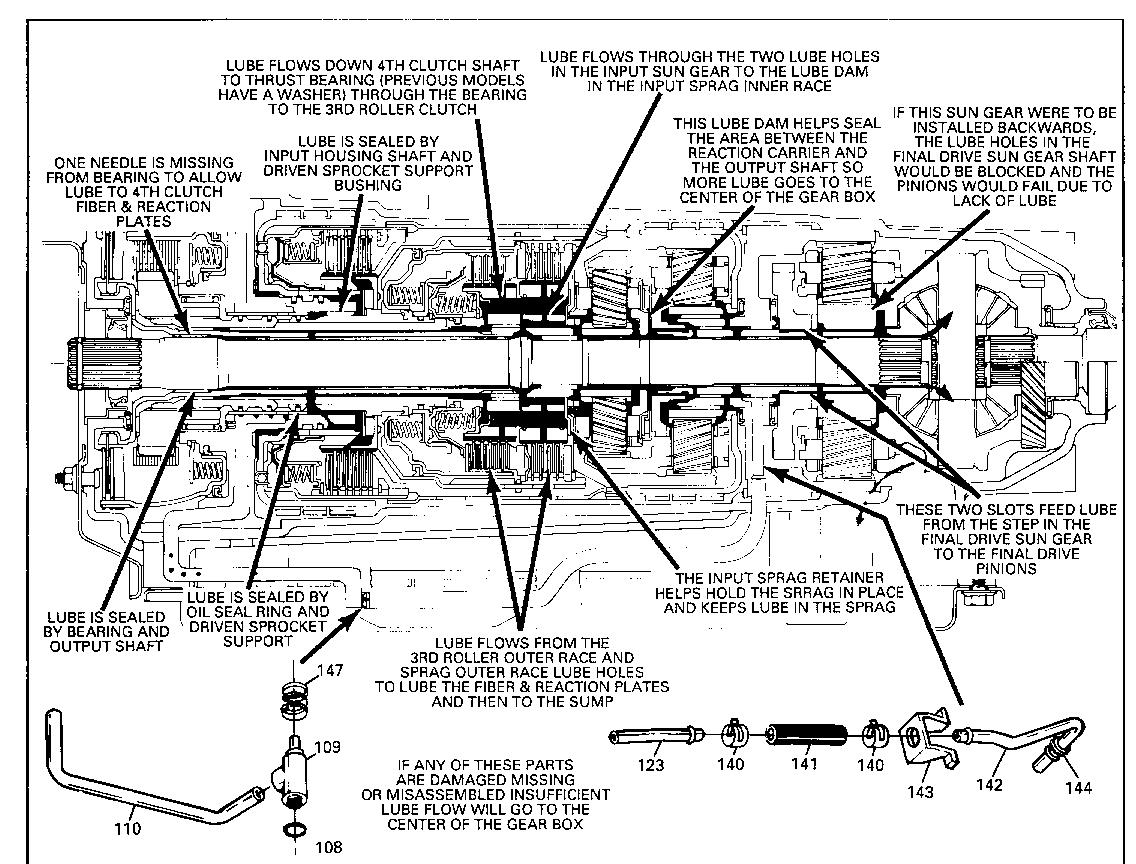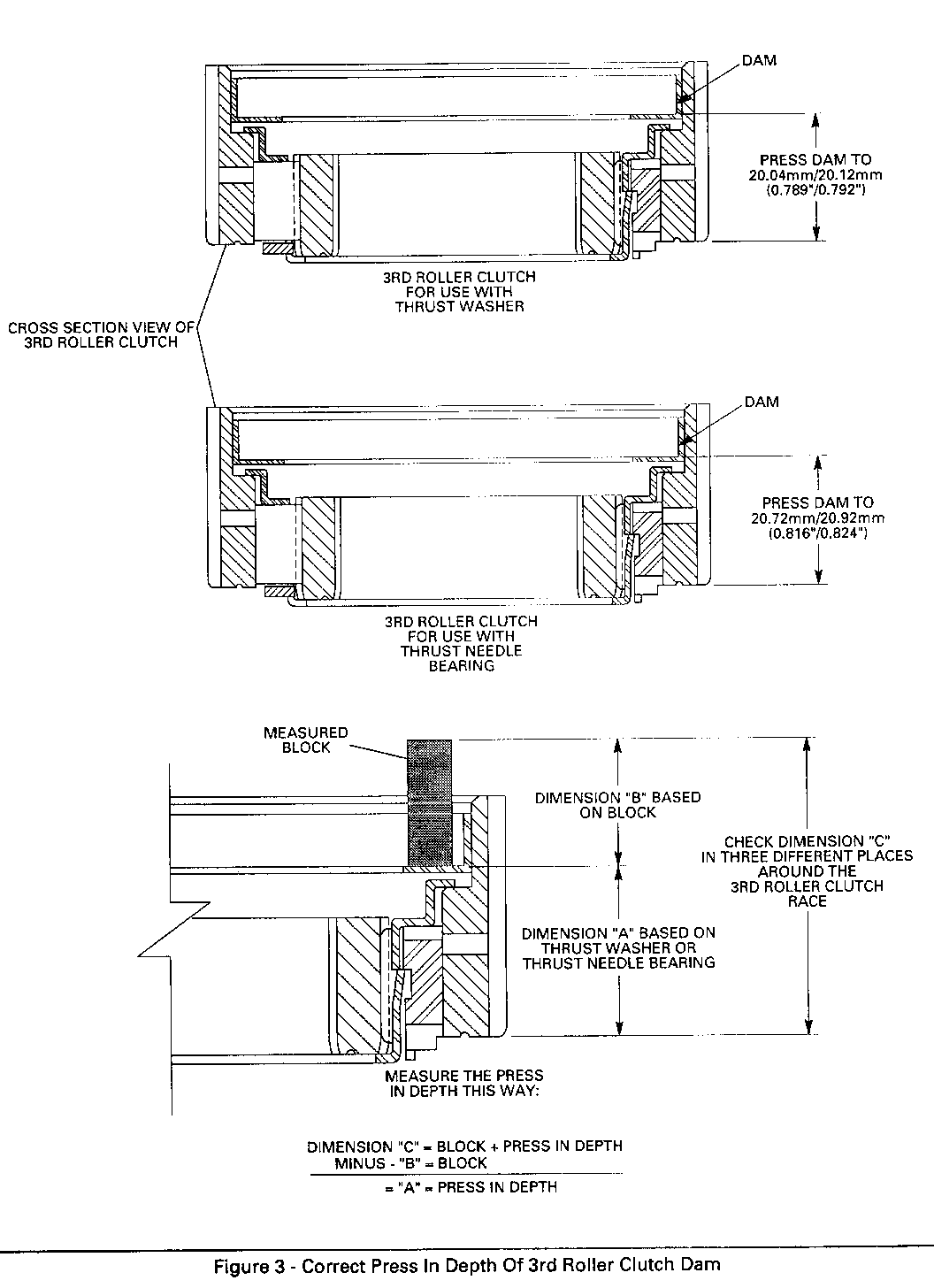NO 3RD GEAR AND/OR NO DRIVE OR REVERSE

SUBJECT: NO THIRD GEAR AND/OR NO DRIVE OR REVERSE - CENTER GEARBOX DISTRESS DIAGNOSIS TIPS ON ALL 1985-1991 CADILLACS WITH THE HYDRA-MATIC 4T60 (THM 440-T4)
Center learbox distress in a Hydra-Matic 4T60 (THM 440-T4) transaxle may result in one or more of the following conditions:
1. No third gear due to a distressed third roller clutch cage. Also, slips in third gear or no third gear.
2. No drive or reverse due to a distressed input sprag clutch.
3. Distressed third and input clutch fiber and reaction (steel) plates.
Several aftermarket publications have been written concerning different ways to modify the Hydra-Matic 4T60 or in an attempt to reduce center gearbox distress. Some of the modifications include grinding slots, lining up lube holes differently, and greatly increasing the fluid level. Do not attempt these modifications or procedures because they may cause durability concerns.
Many changes have been implemented to help reduce center gearbox distress. This bulletin will discuss them and what components should be inspected during an overhaul and reference bulletins already published on these previous changes. Also, some other helpful tips and information about lubrication flow have been added. Refer to Figures 1 and 2. A SRTA unit should be considered when the projected cost of repair exceeds the cost of SRTA replacement.
1. INPUT SPRAG CLUTCH Changes were made to the input sprag clutch during the 1986 model year to improve its durability. Revisions included increasing the width of the sprag assembly to reduce the possibility of rollover. Refer to Cadillac Service Bulletin T-88-101 in Group 7.
2. THIRD ROLLER CLUTCH Changes were made to the third roller clutch twice during the 1989 model year to improve its durability. Revisions included reducing the width of the third roller cam, modifying the third roller lube dam, and eliminating four lube holes on the outside race. With the narrower cam and the number of lube holes reduced, the rollers are less likely to cock or skew when over-running. When the rollers cock or skew, excessive heat is created. Refer to Cadillac Service Bulletins T-90-42 and T-90-65 in Group 7.
3. OUTPUT Changes were made to the output shaft during the 1985 and 1989 model years to improve lubrication to the center gearbox area. Revisions included changing the output shaft bearing from a double row to a single row of needle bearings. Refer to Cadillac Service Bulletins T-88-101 and T-90-65 in Group 7.
4. THIRD CLUTCH ASSEMBLY The third clutch assembly was changed from an 8-plate to a 10-plate design beginning with the 1989 model year. This revision increased the third clutch torque capacity and reduced heat build up during repeat manual lo engagements.
5. INPUT HOUSING The input housing to third roller cam thrust washer was changed to a needle bearing to reduce heat buildup during the 1989 model year. Refer to Cadillac Service Bulletin T-90-42 in Group 7.
When reassembling a third roller clutch, ensure that its lube dam is pressed into the proper depth:
If the third roller clutch is mated to the thrust needle bearing instead of the washer, then press the dam to a depth of 20.72/20.92mm (0.816/0.824") as measured from the bottom side (sprag side) of the outside race to the wide flat edge of the dam as shown in Figure 3.
If using the thrust washer, press the dam (on models so equipped) to a depth of 20.04/20.12mm (0.789/0.792") as measured from the bottom side (sprag side) of the outside race to the wide flat edge of the dam as shown in Figure 3.
IMPORTANT: Measure the press in depth for the dam as shown in Figure 3. Measuring from the top of the third roller clutch race to the dam will be inaccurate because all the machining of the third roller clutch race is based on the opposite side (side that mates to the input sprag). If the dam is pressed in too far or not far enough, it could rub on the third roller clutch cage or the snap ring that retains the third roller clutch return spring and create excess heat to distress the cage of the third roller clutch.
Input housing end play should be checked during any overhaul. Excessive end play could cause too much lubrication fluid to leak out between the input housing thrust washer/bearing and third roller clutch cam. Some leakage is designed in, but too much leakage could cause a durability concern. Refer to the lubrication circuit fluid flow description, Figure 1.
6. INPUT/REACTION CARRIER LUBE DAM The lube dam must be installed on most 1986 and newer models between the input and reaction carriers. Leaving a worn, damaged, or missing lube dam will allow too much lubrication fluid to leak into the bottom pan. Refer to Cadillac Service Bulletin T-88-101 in Group 7.
7. FINAL DRIVE The final drive sun gear lube groove must face toward the parking gear to allow adequate lubrication flow to the final drive pinions. The final drive sun gear shaft has lubrication holes in the shaft that feed fluid into the step in the sun gear, then through the two slots in the parking gear to the final drive pinions. If the final drive sun gear was installed backward, the holes in the final drive sun gear shaft would be blocked, not allowing fluid to lubricate the final drive pinions.
Final drive end play should be checked during any overhaul. Excessive end play would allow the final drive sun gear to move away from the thrust bearing in the final drive and allow too much lube fluid to leak out from the final drive sun gear shaft.
8. LUBE OIL PIPES Check lube oil pipes for correct installation and any damage (plastic cracked, pipes bent, etc.). Ensure the lube oil pipe retainer is in the proper position. A mispositioned or damaged component will leak fu6rication fluid into the bottom pan instead of directing the fluid to the center gearbox area. While bolting down the accumulator cover, make sure the lube oil pipe retainer is not cocked.
9. THERMO ELEMENT An incorrect thermo element height will cause the fluid level to be inaccurate (either too low or too high) when the fluid is up to operating temperatures. Too low a fluid level will cause air to be sucked into the filter, and too high a level will cause fluid foaming due to churning. This will cause many durability concerns including damage to the center of the gearbox Check the height with the thermo element height setting tool, J 34094-A
10. TRANSAXLE OIL COOLER AND LINES Blockage of the transaxle oil cooler and/or lines prevent lubrication fluid from reaching the center gearbox area. A cooler flow test should be performed: correct flow is two quarts of fluid per 30 seconds. Also, the cooler and lines should be flushed. Refer to the appropriate Service Information Manual, Section 7A, for cooler flushing and flow test procedures.
11. LINE PRESSURE Lubrication fluid flow is proportional with line pressures. If the line pressure is below specification, then lubrication fluid flow would be inadequate. Check the line pressure as outlined in the Service Information Manual and reference Cadillac Service Bulletin-T-87-33A in Group 7 for details about vacuum modulator diagnosis.
12. CONVERTER CLUTCH REGULATOR VALVE Check the converter clutch regulator valve for proper operation, binding, sediment, or damage, etc. This valve controls the flow of lubrication - when the Viscous Converter Clutch (VCC) is applied, main line lubrication fluid from the pump pressure regulator is routed past the torque converter directly to the cooler. When VCC is not applied, the fluid is routed through the torque converter, then to the cooler. If the valve is damaged, a new valve is included in service package P/N 8646934. Use only the converter clutch regulator valve from this package.



General Motors bulletins are intended for use by professional technicians, not a "do-it-yourselfer". They are written to inform those technicians of conditions that may occur on some vehicles, or to provide information that could assist in the proper service of a vehicle. Properly trained technicians have the equipment, tools, safety instructions and know-how to do a job properly and safely. If a condition is described, do not assume that the bulletin applies to your vehicle, or that your vehicle will have that condition. See a General Motors dealer servicing your brand of General Motors vehicle for information on whether your vehicle may benefit from the information.
